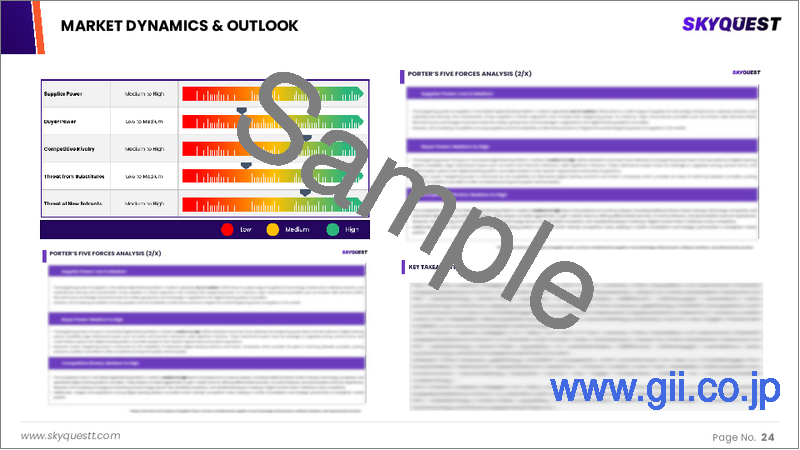|
|
市場調査レポート
商品コード
1806065
スマートグリッドデータアナリティクスの市場規模、シェア、成長分析:アプリケーション別、展開モード別、コンポーネント別、ソリューション別、地域別 - 産業予測、2025年~2032年Smart Grid Data Analytics Market Size, Share, and Growth Analysis, By Application (Transmission and Distribution Management, Energy Efficiency and Conservation), By Deployment mode, By Component, By Solution, By Region - Industry Forecast 2025-2032 |
||||||
|
|||||||
| スマートグリッドデータアナリティクスの市場規模、シェア、成長分析:アプリケーション別、展開モード別、コンポーネント別、ソリューション別、地域別 - 産業予測、2025年~2032年 |
|
出版日: 2025年09月01日
発行: SkyQuest
ページ情報: 英文 184 Pages
納期: 3~5営業日
|
全表示
- 概要
- 目次
スマートグリッドデータアナリティクスの世界市場規模は、2023年に85億米ドルと評価され、2024年の95億4,000万米ドルから2032年には239億5,000万米ドルに成長し、予測期間(2025-2032年)のCAGRは12.2%で成長する見通しです。
スマートグリッドデータアナリティクスの急速な普及により、電力会社は可視化の強化、負荷予測の改善、予知保全の実施が可能になり、最終的にはグリッド効率の安定化と最適化が実現します。エネルギー効率化の取り組み、持続可能性の目標、二酸化炭素排出量削減の推進により、政府やエネルギープロバイダーが高度な分析プラットフォームに投資することで、スマートグリッドデータアナリティクスの世界市場は拡大しています。膨大な量のリアルタイムデータを生成するスマートメーターやIoT対応デバイスの普及に伴い、実用的なインサイトを抽出するスマート分析ツールに対する需要が高まっています。この動向は、特にスマートインフラと規制の強化に取り組む地域において、市場を大きく成長させます。
目次
イントロダクション
- 調査の目的
- 調査範囲
- 定義
調査手法
- 情報調達
- 二次と一次データの方法
- 市場規模予測
- 市場の前提条件と制限
エグゼクティブサマリー
- 世界市場の見通し
- 供給と需要の動向分析
- セグメント別機会分析
市場力学と見通し
- 市場概要
- 市場規模
- 市場力学
- 促進要因と機会
- 抑制要因と課題
- ポーターの分析
主な市場の考察
- 重要成功要因
- 競合の程度
- 主な投資機会
- 市場エコシステム
- 市場の魅力指数(2024年)
- PESTEL分析
- マクロ経済指標
- バリューチェーン分析
- 価格分析
- 技術分析
- ケーススタディ
スマートグリッドデータアナリティクスの市場規模:アプリケーション別、CAGR(2025年~2032年)
- 市場概要
- 送電・配電管理
- エネルギー効率・節約
- 資産管理・保守
- サイバーセキュリティ・コンプライアンス
- スマートメーター・データ管理
スマートグリッドデータアナリティクスの市場規模:展開モード別、CAGR(2025年~2032年)
- 市場概要
- オンプレミス
- クラウドベース
- ハイブリッド
スマートグリッドデータアナリティクスの市場規模:コンポーネント別、CAGR(2025年~2032年)
- 市場概要
- ソフトウェア
- サービス
- ハードウェア
スマートグリッドデータアナリティクスの市場規模:ソリューション別、CAGR(2025年~2032年)
- 市場概要
- 予測的アナリティクス
- 記述的アナリティクス
- 診断的アナリティクス
- 処方的アナリティクス
- コグニティブアナリティクス
スマートグリッドデータアナリティクスの市場規模:地域別、CAGR(2025年~2032年)
- 北米
- 米国
- カナダ
- 欧州
- ドイツ
- スペイン
- フランス
- 英国
- イタリア
- その他欧州地域
- アジア太平洋地域
- 中国
- インド
- 日本
- 韓国
- その他アジア太平洋地域
- ラテンアメリカ
- ブラジル
- その他ラテンアメリカ地域
- 中東・アフリカ
- GCC諸国
- 南アフリカ
- その他中東・アフリカ
競合情報
- 上位5社の比較
- 主要企業の市場ポジショニング(2024年)
- 主な市場企業が採用した戦略
- 最近の市場動向
- 企業の市場シェア分析(2024年)
- 主要企業の企業プロファイル
- 企業の詳細
- 製品ポートフォリオ分析
- 企業のセグメント別シェア分析
- 収益の前年比比較(2022-2024年)
主要企業プロファイル
- Honeywell
- Eaton
- Verizon
- Landis+Gyr
- Siemens
- Oracle
- TMobile
- IBM
- General Electric Vernova
- Cisco
- Schneider Electric
- SAP
- ABB
- Itron
結論と提言
Global Smart Grid Data Analytics Market size was valued at USD 8.5 billion in 2023 and is poised to grow from USD 9.54 billion in 2024 to USD 23.95 billion by 2032, growing at a CAGR of 12.2% during the forecast period (2025-2032).
The rapid adoption of smart grid data analytics is enabling utilities to enhance visualization, improve load forecasting, and implement predictive maintenance, ultimately stabilizing and optimizing grid efficiencies. Driven by energy efficiency initiatives, sustainability goals, and the push for reduced carbon emissions, the global market for smart grid data analytics is expanding as governments and energy providers invest in advanced analytics platforms. With the proliferation of smart meters and IoT-enabled devices generating vast amounts of real-time data, there is a growing demand for smart analytics tools to extract actionable insights. This trend positions the market for substantial growth, particularly in regions committed to smart infrastructure and regulatory advancements.
Top-down and bottom-up approaches were used to estimate and validate the size of the Global Smart Grid Data Analytics market and to estimate the size of various other dependent submarkets. The research methodology used to estimate the market size includes the following details: The key players in the market were identified through secondary research, and their market shares in the respective regions were determined through primary and secondary research. This entire procedure includes the study of the annual and financial reports of the top market players and extensive interviews for key insights from industry leaders such as CEOs, VPs, directors, and marketing executives. All percentage shares split, and breakdowns were determined using secondary sources and verified through Primary sources. All possible parameters that affect the markets covered in this research study have been accounted for, viewed in extensive detail, verified through primary research, and analyzed to get the final quantitative and qualitative data.
Global Smart Grid Data Analytics Market Segments Analysis
Global Smart Grid Data Analytics Market is segmented by Application, Deployment mode, Component, Solution and region. Based on Application, the market is segmented into Transmission and Distribution Management, Energy Efficiency and Conservation, Asset Management and Maintenance, Cybersecurity and Compliance and Smart Metering and Data Management. Based on Deployment mode, the market is segmented into On-premise, Cloud-based and Hybrid. Based on Component, the market is segmented into Software, Services and Hardware. Based on Solution, the market is segmented into Predictive Analytics, Descriptive Analytics, Diagnostic Analytics, Prescriptive Analytics and Cognitive Analytics. Based on region, the market is segmented into North America, Europe, Asia Pacific, Latin America and Middle East & Africa.
Driver of the Global Smart Grid Data Analytics Market
The rising adoption of smart meters globally significantly fuels growth in the smart grid data analytics market. These advanced devices generate vast quantities of real-time data concerning power usage, load fluctuations, and outages, which are crucial for utilities aiming to optimize power distribution, enhance supply forecasting, and improve pricing strategies. The drive from utilities and regulatory agencies to implement smart meters in various regions further underscores this trend. As the deployment of smart meters expands, the influx of data presents valuable opportunities for analytics, allowing organizations to transform operational data into meaningful insights that can inform strategic decisions and improve efficiency.
Restraints in the Global Smart Grid Data Analytics Market
The high initial costs associated with upgrading infrastructure present a significant challenge for the adoption of smart grid data analytics. Implementing smart grids necessitates substantial upfront investments in advanced meters, sensors, communication networks, and analytical platforms. This financial burden often hinders small- and mid-sized utilities from effectively deploying essential technology for large-scale smart grid initiatives, especially in developing nations that lack the financial resources for such investments. Although operational savings may be realized over time, the substantial capital expenditures required at the outset deter widespread market penetration and adaptation, limiting the overall growth potential for smart grid data analytics solutions.
Market Trends of the Global Smart Grid Data Analytics Market
The Global Smart Grid Data Analytics market is witnessing a significant shift towards the integration of AI and Machine Learning for predictive analytics. Utilities are increasingly adopting these advanced technologies to enhance operational efficiencies and improve grid reliability by forecasting energy demand and identifying anomalies. Through the analysis of historical and real-time data, machine learning algorithms facilitate the recognition of consumption patterns, enabling proactive responses to potential outages or failures. This trend underscores a broader move from reactive to proactive grid management, driving rapid decision-making and optimizing asset performance, thus positioning AI and ML as crucial pillars for the future landscape of smart grid analytics.
Table of Contents
Introduction
- Objectives of the Study
- Scope of the Report
- Definitions
Research Methodology
- Information Procurement
- Secondary & Primary Data Methods
- Market Size Estimation
- Market Assumptions & Limitations
Executive Summary
- Global Market Outlook
- Supply & Demand Trend Analysis
- Segmental Opportunity Analysis
Market Dynamics & Outlook
- Market Overview
- Market Size
- Market Dynamics
- Drivers & Opportunities
- Restraints & Challenges
- Porters Analysis
- Competitive rivalry
- Threat of substitute
- Bargaining power of buyers
- Threat of new entrants
- Bargaining power of suppliers
Key Market Insights
- Key Success Factors
- Degree of Competition
- Top Investment Pockets
- Market Ecosystem
- Market Attractiveness Index, 2024
- PESTEL Analysis
- Macro-Economic Indicators
- Value Chain Analysis
- Pricing Analysis
- Technology Analysis
- Case Studies
Global Smart Grid Data Analytics Market Size by Application & CAGR (2025-2032)
- Market Overview
- Transmission and Distribution Management
- Energy Efficiency and Conservation
- Asset Management and Maintenance
- Cybersecurity and Compliance
- Smart Metering and Data Management
Global Smart Grid Data Analytics Market Size by Deployment mode & CAGR (2025-2032)
- Market Overview
- On-premise
- Cloud-based
- Hybrid
Global Smart Grid Data Analytics Market Size by Component & CAGR (2025-2032)
- Market Overview
- Software
- Services
- Hardware
Global Smart Grid Data Analytics Market Size by Solution & CAGR (2025-2032)
- Market Overview
- Predictive Analytics
- Descriptive Analytics
- Diagnostic Analytics
- Prescriptive Analytics
- Cognitive Analytics
Global Smart Grid Data Analytics Market Size & CAGR (2025-2032)
- North America (Application, Deployment mode, Component, Solution)
- US
- Canada
- Europe (Application, Deployment mode, Component, Solution)
- Germany
- Spain
- France
- UK
- Italy
- Rest of Europe
- Asia Pacific (Application, Deployment mode, Component, Solution)
- China
- India
- Japan
- South Korea
- Rest of Asia-Pacific
- Latin America (Application, Deployment mode, Component, Solution)
- Brazil
- Rest of Latin America
- Middle East & Africa (Application, Deployment mode, Component, Solution)
- GCC Countries
- South Africa
- Rest of Middle East & Africa
Competitive Intelligence
- Top 5 Player Comparison
- Market Positioning of Key Players, 2024
- Strategies Adopted by Key Market Players
- Recent Developments in the Market
- Company Market Share Analysis, 2024
- Company Profiles of All Key Players
- Company Details
- Product Portfolio Analysis
- Company's Segmental Share Analysis
- Revenue Y-O-Y Comparison (2022-2024)
Key Company Profiles
- Honeywell
- Company Overview
- Business Segment Overview
- Financial Updates
- Key Developments
- Eaton
- Company Overview
- Business Segment Overview
- Financial Updates
- Key Developments
- Verizon
- Company Overview
- Business Segment Overview
- Financial Updates
- Key Developments
- Landis+Gyr
- Company Overview
- Business Segment Overview
- Financial Updates
- Key Developments
- Siemens
- Company Overview
- Business Segment Overview
- Financial Updates
- Key Developments
- Oracle
- Company Overview
- Business Segment Overview
- Financial Updates
- Key Developments
- TMobile
- Company Overview
- Business Segment Overview
- Financial Updates
- Key Developments
- IBM
- Company Overview
- Business Segment Overview
- Financial Updates
- Key Developments
- General Electric Vernova
- Company Overview
- Business Segment Overview
- Financial Updates
- Key Developments
- Cisco
- Company Overview
- Business Segment Overview
- Financial Updates
- Key Developments
- Schneider Electric
- Company Overview
- Business Segment Overview
- Financial Updates
- Key Developments
- SAP
- Company Overview
- Business Segment Overview
- Financial Updates
- Key Developments
- ABB
- Company Overview
- Business Segment Overview
- Financial Updates
- Key Developments
- Itron
- Company Overview
- Business Segment Overview
- Financial Updates
- Key Developments





